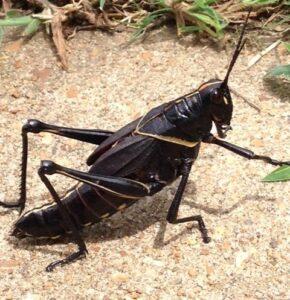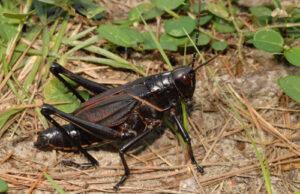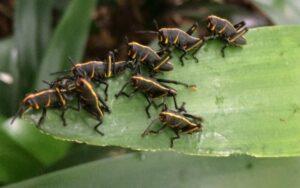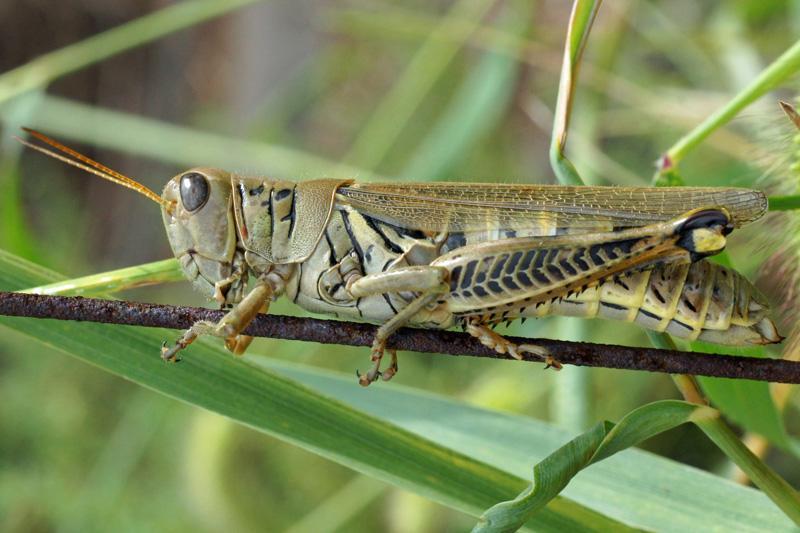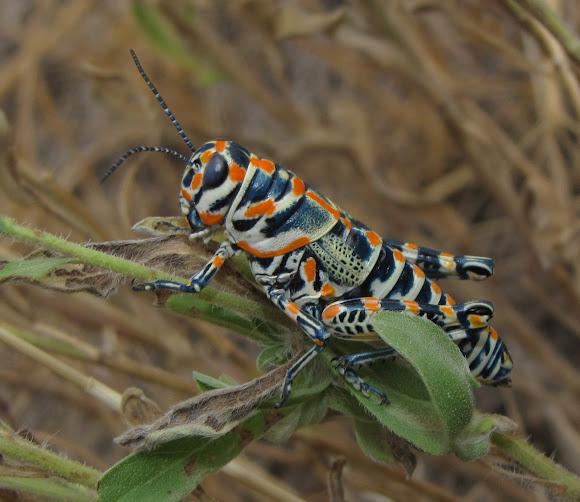Eastern Lubber Grasshopper (Romalea microptera)
Updated on
27/10/2022Eastern Lubber Grasshopper is the only species in the Romalea genus and the most recognizable type of grasshopper in the Southeastern US. Its common names include Florida lubber grasshopper, Florida lubber, or simply lubber.
It is considered a garden pest because it’s an avid eater and can deflate plants and trees quickly unless controlled.
Scientific Classification
- Class:Insecta
- Order:Orthoptera
- Suborder:Caelifera
- Family:Romaleidae
- Subfamily:Romaleinae
- Tribe:Romaleini
- Genus:Romalea
- Species:R. microptera
Conservation Status
Description
One of the largest grasshopper species, the adults reach lengths of over 3 inches (8cm). Their wings are small, reaching only halfway to their abdomen, and can’t be used for flying.
Like most insects, females are larger, reaching up to 3.5 inches (9cm) in size.
Adults vary in color, the most common coloration being a yellow or tawny base color with black and orange bands and blotches. Darker variations are also found where yellow becomes the minor color, and black or dark brown becomes the primary color.
The front wings have a pinkish tint along their middle part, while the hind wings are rose or pink.
They have a pair of short yellow antenna that becomes black towards the top.
Distribution: Southern North Carolina to South Carolina, Florida, Missouri, Arizona, and Georgia in the south, and the west through Mississippi, Alabama, Louisiana, and Arkansas to central Texas
Habitat: Weedy vegetations and fields, as well as open pinewoods
Do They Bite/Sting: No; their foul-smelling fluid is also harmless to humans
Lifespan: 5-6 months
Predators: Loggerhead shrike
Behavior and Characteristics
Diet
They eat a wide range of plants, including vegetables, crops, and ornamental plants, with a particular preference for cabbage, peas, kale, lettuce, beans, amaryllis, Amazon lily, narcissus, crinum, lantana, and butterfly weed. They are less fond of plants like tomato, eggplant, sweet corn, pepper, okra, celery, and fennel.
Being voracious feeders, these grasshoppers can completely defoliate plants and destroy gardens.
Self Defense

The first defense system of these grasshoppers is their bright coloration (aposematism), which is a warning for predators.
If they are disturbed or caught, they secrete a foul-tasting, dark, smelly foamy toxic fluid from their thorax, which they can even spray up to 6 inches.
This poisonous secretion can severely harm
small animals and birds if they eat the grasshopper. Their only predator, the loggerhead shrike, kills the grasshopper first and then lets it out in the sun for the toxin to subside before they eat it.
These lubbers can make a loud hissing noise to scare off their enemies.
Life Cycle
Though found throughout the year, adults are commonly seen from March-April to October-November, with July-August being the peak season. They have one generation per year.
1. Egg Stage
Yellowish-brown eggs are laid in batches of 30-50 just under the soil surface. The eggs mature in cooler temperatures and are ready to hatch when it gets warmer by the following spring, around February and March (based on the region).
2. Nymph Stage
The juveniles or nymphs start appearing simultaneously. They are wingless and much smaller than the adults, with black with orange, red, and yellow stripes.
3. Adult Stage
The nymphs typically reach the adult stage after 5 molts.
Getting Rid of Eastern Lubber Grasshopper
Since they can wreak havoc on vegetables and ornamental plants, seeing them in one’s garden can never be good news. Getting rid of the adults is difficult, and the best way to kill them is to spray insecticides on them directly. Baits may also work, but they need to be placed in areas with no other plants or food materials for the lubbers.
FAQs
Though lubbers can be poisonous to small animals, dogs and cats are not one of them. However, if your pet eats a lot of these grasshoppers, it may cause a stomach upset.
Source
bugguide.net, fieldstation.wp2.olemiss.edu, entnemdept.ufl.edu, lh5.ggpht.com, researchgate.net, misssmartyplants.com





